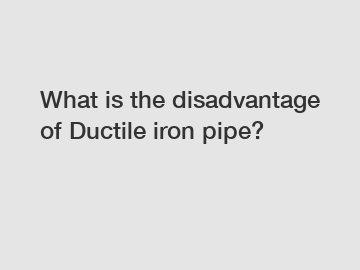What is the disadvantage of Ductile iron pipe?
What is the disadvantage of Ductile iron pipe?
Ductile iron pipe has been widely used in various industries for its durability and strength. However, like any other material, it also has its disadvantages. In this article, we will explore the drawbacks of using Ductile iron pipe and discuss why they may be a cause for concern in certain applications.
1. Susceptible to corrosion:

Despite its corrosion-resistant properties, Ductile iron pipe is still susceptible to corrosion over time. This can occur due to various factors such as soil conditions, aggressive water properties, and stray electrical currents. Corrosion can lead to the formation of rust, which weakens the pipe and reduces its lifespan. Although protective coatings are often applied to Ductile iron pipes, they may not provide long-term protection, especially in highly corrosive environments.
2. Relatively heavyweight:
Compared to some alternate pipe materials like plastic or PVC, Ductile iron pipes are relatively heavy. This can make installation and transportation more challenging and expensive. The weight of the pipes can also put a strain on the supporting structures, requiring additional reinforcements. In applications where weight is a significant concern, such as underground installations or projects with limited load-bearing capabilities, Ductile iron pipes may not be the optimal choice.
3. Reduced flow capacity:
Another disadvantage of Ductile iron pipes is their reduced flow capacity compared to some other pipe materials. The inner surface of these pipes tends to be rougher, leading to increased friction and subsequently reducing the flow of water or other fluids. In instances where high flow rates are crucial, such as water supply systems or irrigation networks, the reduced flow capacity may negatively impact the overall performance and efficiency.
4. Limited flexibility:
Unlike some flexible pipe materials, Ductile iron pipes have limited flexibility and ductility. They cannot bend or accommodate changes in alignment or direction easily. This lack of flexibility can make installation in areas with complex terrain or curved paths more challenging and require additional fittings, bends, or joints. These additional components can create potential weak points in the pipeline, increasing the risk of leaks or failures.
Overall, while Ductile iron pipes offer numerous advantages, including great tensile strength, impact resistance, and durability, these disadvantages should be carefully evaluated before choosing this material for a specific application. Is the corrosion resistance adequate for the intended environment? Can the weight be managed during installation? Is the flow capacity sufficient for the desired flow rates? Is the lack of flexibility a concern? These questions must be answered to make an informed decision.
In conclusion, the disadvantages associated with Ductile iron pipes can be significant considerations in certain applications. It is essential to carefully assess the specific requirements of a project and weigh them against the advantages and disadvantages of using Ductile iron pipes. Engineering professionals and project managers should engage in thorough planning, evaluation, and inspection to ensure that the selected pipe material aligns with the project's long-term goals and performance expectations.
Want more information on c900 ductile iron pipe, astm ductile iron pipe, heavy duty ductile iron pipe? Feel free to contact us.

Comments
0